Whistler, British Columbia 作者: 来源: 发布时间:2021-03-29
I. Population and Area
₋ Area
Land: 1.78 km2 (0.69 sq mi)
₋ Population (2016)
Total: 489
Density: 270/km2 (710/sq mi)
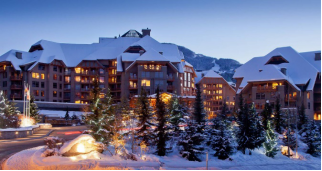
I. Natural Geography
₋ Whistler (Squamish language: Sḵwiḵw) is a resort municipality in the southern Pacific Ranges of the Coast Mountains in the province of British Columbia, Canada, approximately 125 km (78 mi) north of Vancouver and 36 km (22 mi) south of the town of Pemberton. Incorporated as the Resort Municipality of Whistler (RMOW), it has a permanent population of approximately 11,854, plus a larger but rotating population of seasonal workers, typically younger people from beyond British Columbia, notably from Australia and Europe.
₋ Over two million people visit Whistler annually, primarily for alpine skiing and snowboarding and, in summer, mountain biking at Whistler Blackcomb. Its pedestrian village has won numerous design awards and Whistler has been voted among the top destinations in North America by major ski magazines since the mid-1990s. During the 2010 Winter Olympics, Whistler hosted most of the alpine, Nordic, luge, skeleton, and bobsled events.
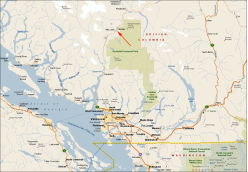
₋ Transportation
Whistler is located on British Columbia Highway 99, also known as the "Sea to Sky Highway", approximately 58 km (36 mi) north of Squamish, and 125 km (76 mi) from Vancouver. The highway connects Whistler to the British Columbia Interior via Pemberton-Mount Currie to Lillooet and connections beyond to the Trans-Canada and Cariboo Highways.
Elite-class rail service is only provided at the Whistler railway station between Vancouver and Jasper by the Rocky Mountaineer, using Canadian National Railway tracks from North Vancouver via Whistler and Prince George. The station for tour passengers embarking from Whistler is in the Southside area, between Nita and Alpha Lakes.
Local bus transit service is provided by the Whistler and Valley Express, which also provides service to Pemberton.
A shuttle bus service from the Vancouver Airport and Downtown Vancouver is provided by the Whistler Shuttle and YVR Skylynx.
Vancouver International Airport
▫ Vancouver International Airport (IATA: YVR, ICAO: CYVR) is the main international airport for Whistler residents and tourists and is located 140 km (87 mi) south.
Pemberton Regional Airport
▫ Pemberton Regional Airport (ICAO: CYPS) is a public airport serving Pemberton and Whistler. It is the closest airport for fixed wing non-amphibious aircraft and is 38 minutes north of Whistler. There are no scheduled flights but three charter services operate out of the airport.
Whistler (Municipal) Heliport
▫ Whistler (Municipal) Heliport (TC LID: CBE9) is a public heliport operated by the Whistler Heliport Society. Currently there are no scheduled flights but charter services to/from Vancouver International Airport, Vancouver/Harbour (Public) Heliport and Victoria Harbour (Camel Point) Heliport (TC LID: CBF7) are available.
Whistler/Green Lake Water Aerodrome
▫ Whistler/Green Lake Water Aerodrome (ICAO: YWS, TC LID: CAE5) is a public floatplane base owned and operated by Harbour Air Group and Whistler Air. Seasonal scheduled flights are provided by Harbour Air Seaplanes and West Coast Air to Victoria Inner Harbour Airport and Vancouver Harbour Water Airport. The seaplane base is located at the Nicklaus North subdivision on the South end of Green Lake.
II. ECONOMY
₋ The average Whistler salary in Canada is $33,150 per year or $17 per hour. Entry level positions start at $24,375 per year while most experienced workers make up to $56,355 per year.
₋ Website: https://neuvoo.ca/salary/?job=Whistler#:~:text=Find%20out%20what%20is%20the%20average%20Whistler%20salary&text=The%20average%20Whistler%20salary%20in,up%20to%20%2456%2C355%20per%20year.
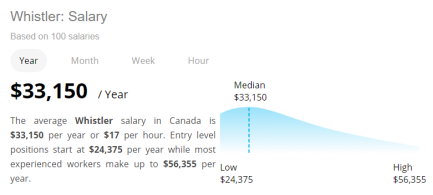
III. Industrial Characteristics
Non-Indigenous trappers and prospectors began to pass through the area with the clearing of the Pemberton Trail between Lillooet and the Pacific coast in 1877. In 1914, Rainbow Lodge opened on Alta Lake, adjacent to Whistler Mountain. The fishing lodge began to draw visitors to the area. That same year, the Pacific Great Eastern Railway (see British Columbia Railway) reached nearby Pemberton. The railway brought more tourists and industries to the Whistler Valley. The community of Alta Lake slowly grew over the decades that followed.
In the early 1970s, this area of British Columbia had few residents, and what would become Whistler was little more than a few ski cabins. The provincial government, however, created a unique local government structure that allows Whistler to provide both public and private services. The passing of the Resort Municipality of Whistler Act in 1975 opened the area to resort development. An extensive system of lifts and ski runs was built at Whistler and Blackcomb mountains, and Whistler Village was developed at their western bases. Whistler Village is not the only development in the resort municipality; Whistler Creek is the original settlement and there are 17 other subdivisions.
₋ Website: https://www.thecanadianencyclopedia.ca/en/article/whistler
IV. Attractions
1. Brandywine Falls Provincial Park
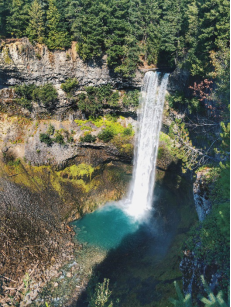
₋ Brandywine Falls Provincial Park is a provincial park in British Columbia, Canada, located adjacent to BC Highway 99 between Garibaldi and Whistler, British Columbia. It is managed by Sea to Sky Parks for BC Parks.
₋ The 70-meter (230 ft) falls are located on Brandywine Creek, which has its origin in the Powder Mountain Icefield to the west, and are formed by the lip of a lava flow flanking the west bank of the Cheakamus River. Just downstream of the falls is Daisy Lake.
₋ At least four basaltic lava flows of Late Pleistocene age comprise the vertical walls surrounding Brandywine Falls. These Cheakamus Valley basalts are part of the Garibaldi Volcanic Belt, a northwest-southeast chain of volcanoes and related lavas that form the northern end of the Cascade Volcanic Arc. The lava flowed over deposits of glacial till, silt, and gravel then cooled creating a hard weather resistant top cap over loose unconsolidated material easily weathered. The perfect conditions for a water fall creation. 10,000 years later ice from the Fraser Glaciation receded from Cheakamus Valley releasing melt water and creating Brandywine Creek. This worked its way downstream and started to erode the looser material and undercut the hard basalt top layer, creating the falls.
₋ Tel: Phone: +1 800-689-9025
₋ Website: http://bcparks.ca/explore/parkpgs/brandywine_falls/
2. Whistler Blackcomb
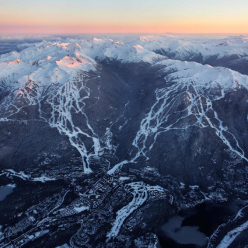
₋ Whistler Blackcomb is a ski resort located in Whistler, British Columbia, Canada. By many measures it is the largest ski resort in North America and has the greatest uphill lift capacity. It features the Peak 2 Peak Gondola for moving between Whistler and Blackcomb mountains at the top. With all of this capacity, Whistler Blackcomb is also often the busiest ski resort, often surpassing 2 million visitors a year.
₋ Whistler was originally conceived as part of a bid to win the 1968 Winter Olympics. Although the bid failed, construction started anyway and the resort opened for the first time in January 1966. Blackcomb mountain, originally a separate entity, opened for business in December 1980. The two resorts underwent a period of intense rivalry through the 1980s and 90s, with constant upgrades and improvements that were unseen at other resorts. By the mid-1990s the area was repeatedly named the best resort in many skiing magazines. Intrawest, the BC real estate firm that developed Blackcomb, purchased Whistler in 1997 and fully merged their operations in 2003.
₋ Whistler Blackcomb was the centrepiece of a renewed bid on the part of nearby Vancouver for the 2010 Winter Olympics, which they won in July 2003. Whistler Blackcomb hosted the alpine skiing events, including the men's and women's Olympic and Paralympic alpine skiing disciplines of downhill, Super-G, slalom, giant slalom and super combined. In contrast with Cypress Mountain - which hosted the freestyle skiing and all snowboard events, and was plagued with a lack of fresh, natural snow during the Olympics leading to many complaints over hill quality - Whistler Blackcomb had the second-highest snowfall on record with 1,432 cm (over 14 metres) by the end of the 2009/10 season.[1]
₋ Over the next decade, Intrawest expanded by purchasing additional ski resorts across North America, before expanding into golf and other resorts as well. Whistler Village, widely recognized for its livable design, formed the basis of similar Tyrolian-inspired developments at their expanding series of resorts, as well as other resorts that hired Intrawest to build similar developments on their behalf. In 2010 Intrawest sold off much of its 75% interest in Whistler Blackcomb Resort via a public share offering.
₋ On August 8, 2016, American company Vail Resorts bought Whistler Blackcomb Holdings for C$1.39 billion. Nippon Cable minority interest in Whistler Blackcomb resort has continued throughout the ownership changes, by way of ownership of a 25% interest of the Whistler and Blackcomb partnerships.
₋ Website: https://www.whistlerblackcomb.com/
₋ Phone: (604) 967-8950
3. Whistler Mountain
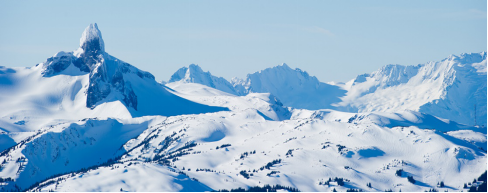
₋ Whistler Mountain is a mountain in the Fitzsimmons Range of the Pacific Ranges of the Coast Mountains, located on the northwestern edge of Garibaldi Provincial Park. It is the location of the Whistler-Blackcomb ski resort and the town of Whistler, British Columbia.
₋ Previously, the mountain was called London Mountain, named after a mining claim in the area. The locality was called Alta Lake before the creation of the Resort Municipality of Whistler in the 1970s, but the mountain's name had already been changed in 1965 as the associations with London's bad weather were deemed to be bad for advertising purposes. With the advent of the ski resort in the late 1960s the name was changed to "Whistler" to represent the whistling calls of the marmots, which are also known as "whistlers", that live in the alpine areas of the mountain.
₋ Because of the mountain's proximity to Garibaldi Provincial Park, ski lifts are regularly used to quickly reach the alpine, and ski tour into the park. The summit is home to the Whistler Peak chair, and this makes it one of the most travelled summits in British Columbia.
₋ The mountain forms part of a major ski and snowboard resort.
₋ Whistler Mountain contains shale that originated as mud on the seafloor of a former ocean. This same shale formation forms rocks in other locations throughout southwestern British Columbia. The most common rocks that comprise Whistler Mountain are andesite and dacite lava flows. These lava flows and the associated shale form part of a rock assemblage called the Gambier Group. This geologic group was created within a shallow underwater basin about 100 million years ago during the Early Cretaceous period. Granular material, such as clay, sand and silt, was carried into the ancient ocean by rivers that existed during the Cretaceous period. As Cretaceous rivers continuously sent granular material into the former ocean, it was deposited yearly to eventually form layers of sedimentary material. Once the sedimentary material was compressed, it created the shale that now forms portions of Whistler Mountain. The andesite and dacite lava flows were deposited when volcanic eruptions created a series of volcanic islands and produced lava flows in the ancient ocean.
₋ Once the volcanic and sedimentary rocks of the Gambier Group were formed, they began to deform, crumple and uplift due to the extreme pressures created by movement of the North American Plate and the tectonic plates in the Pacific Ocean. The large masses of solidified lava that formerly created the volcanic island chain and underwater lava flows yielded by demolishing into massive, mountain-sized blocks while the less dense, thinly layered shale was compressed, folded and crushed between the associated lavas. In contrast, nearby volcanic landforms in the Garibaldi Lake area, such as The Black Tusk, are of relatively recent volcanic origin and form part of a chain of volcanoes called the Garibaldi Volcanic Belt.
₋ Website: https://www.whistler.com/skiing/
V. History
₋ The Whistler Valley is located around the pass between the headwaters of the Green River and the upper-middle reaches of the Cheakamus. It is flanked by glaciated mountains on both sides; the Garibaldi Ranges on the side that contains the ski mountains, and a group of ranges with no collective name but which are part of the larger Pacific Ranges and are essentially fore-ranges of the Pemberton Icefield. Although there are a few other routes through the maze of mountains between the basin of the Lillooet River just east, the Cheakamus-Green divide is the lowest and most direct.
₋ The first British survey by the Royal Navy took place in the 1860s. These surveyors named the mountain London Mountain because of the heavy fog and cloud typically gathering around the mountain, but the area informally acquired the name "Whistler" due to the call of the hoary marmot. In the late 19th century, a trail was cut through the valley, linking Lillooet via Pemberton with Burrard Inlet via a pass from Squamish to the Seymour River. The trail was completed in 1877, but because of the difficult and unforgiving terrain, it was only used once for its intended purpose, which was to drive cattle. The area began to attract trappers and prospectors (such as John Millar and Henry Horstman) who established small camps in the area in the early 20th century. The area began to gain recognition with the arrival of Myrtle and Alex Philip, who in 1914 purchased 10 acres (4.0 ha) of land on Alta Lake and established the Rainbow Lodge. The Philips had relocated from Maine to Vancouver in 1910, and had heard rumours of the natural beauty of the area from Pemberton pioneer John Millar. After an exploratory journey, the couple was convinced. Rainbow Lodge and other railway-dependent tourist resorts were collectively known as Alta Lake. Along with the rest of the valley bridging the Cheakamus and Green River basins, they became part of British Columbia's first Resort Municipality in 1975.
₋ Completion of the Pacific Great Eastern Railway in 1914 greatly reduced the travel time from three days, providing ease of access from Vancouver, and the Rainbow Lodge gained a reputation as the most popular vacation destination west of the Rockies. The lodge was primarily a summer destination, with boating, fishing and hiking among the most popular activities, and soon other lodges began to open not just on Alta Lake, but on other valley lakes as well.
₋ Appreciation of the outdoors was not the only activity in the valley, however. Logging was a boom industry. During the first half of the 20th century, most of the lower slopes of the surrounding mountains were cleared of old growth. At its peak, four mills were in operation, most located around Green Lake. Prospecting and trapping were pursued as well, though no claims of great value were ever staked.
VI. Other Information
₋ 1968 and 1976 Winter Olympic bids
Until the 1960s, this quiet area was without basic infrastructure. There were no sewage facilities, water, or electricity, and no road from Squamish or Vancouver. In 1962, four Vancouver businessmen began to explore the area with the intent of building a ski resort and bidding for the 1968 Winter Olympics. Garibaldi Lift Company was formed, shares were sold, and in 1966, Whistler Mountain opened to the public.
Later, the town, then still known as Alta Lake, was offered the 1976 Winter Olympics after the selected host city Denver declined the games due to funding issues. Alta Lake Whistler declined as well, after elections ushered in a local government less enthusiastic about the Olympics. The 1976 Winter Olympics were ultimately held in Innsbruck, Austria.
₋ 2010 Winter Olympics
Whistler was the Host Mountain Resort of the Vancouver 2010 Winter Olympics and Paralympic Games, the first time the International Olympic Committee has bestowed that designation on a community. Whistler hosted the alpine technical and speed events, the sliding events at Fitzsimmons Creek, the Nordic events in the nearby Callaghan Valley and all the Paralympic events except the opening ceremonies, sledge hockey and wheelchair curling.
The Whistler Olympic and Paralympic Village (commonly referred to as the Athlete's village) housed around 2,400 athletes, coaches, trainers and officials. Post-games, the site has been turned into a new residential neighbourhood Cheakamus Crossing.
VII. Contact Information
₋ Government
Governing body: Whistler Town Council
Mayor: Jack Crompton
₋ Contact
TEL: Call 1.604.932.0606 and request to speak with a Mandarin-speaking agent.
Website: https://www.whistler.com/contact/
